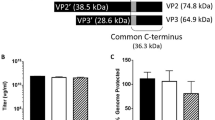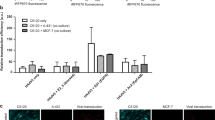Abstract
In this study we analyzed two ways of retargeting of Ad-vectors to human pancreatic carcinoma with the aim of enhancing the gene transfer efficiency. First, we analyzed the expression of the epidermal growth factor receptor (EGFR) on primary, as well as established pancreatic carcinoma cells by flow cytometry which revealed high expression levels of EGFR on the surface of these cells. We showed that EGFR-retargeted entry pathway using a bispecific fusion protein formed by a recombinant soluble form of truncated Coxsackie and Adenovirus Receptor (sCAR) genetically fused with human EGF (sCAR-EGF) redirects them to the EGFR leading to an enhanced gene transfer efficiency to pancreatic carcinoma cells. Since flow cytometry revealed absence of CAR expression, but the presence of at least one of both αv integrins on the pancreatic carcinoma cells, a second way of targeting was investigated using a genetically modified Ad vector which has an RGD (Arg-Gly-Asp)-containing peptide inserted into the HI-loop of the fiber knob. This RGD targeted Ad (AdlucRGD) revealed efficient CAR-independent infection by allowing binding to cellular integrins resulting in a dramatic enhancement of gene transfer. These findings have direct relevance for Ad-vector based gene therapy strategies for pancreatic carcinoma.
This is a preview of subscription content, access via your institution
Access options
Subscribe to this journal
Receive 12 print issues and online access
$259.00 per year
only $21.58 per issue
Buy this article
- Purchase on Springer Link
- Instant access to full article PDF
Prices may be subject to local taxes which are calculated during checkout





Similar content being viewed by others
References
Humphreys MJ, Greenhalf W, Neoptolemos JP, Ghaneh P . The potential for gene therapy in pancreatic cancer Int J Pancreatol 1999 26: 5–21
Von Hoff DD, Goodwin AL, Garcia L . Advances in treatment of patients with pancreatic cancer: improvement in symptoms and survival time Br J Cancer 1998 78: 9–13
Pearson AS et al. Factors limiting adenovirus-mediated gene transfer into human lung and pancreatic cancer cell lines Clin Cancer Res 1999 5: 4208–4213
Wickham TJ, Mathias P, Cheresh DA, Nemerov GR . Integrins αvβ3 and αvβ5 promote adenovirus internalization, but not virus attachment Cell 1993 73: 309–319
Bergelson JM et al. Isolation of a common receptor for coxsackie B viruses and adenoviruses 2 and 5 Science 1997 275: 1320–1323
Huang S, Endo RI, Nemerow GR . Upregulation of integrins αvβ3 and αvβ5 on human monocytes and T lymphocytes facilitate adenovirus-mediated gene delivery J Virol 1995 69: 2257–2263
Goldman MJ, Wilson JM . Expression of αvβ5 integrin is necessary for efficient adenovirus-mediated gene transfer in the human airway J Virol 1995 69: 5951–5958
Hemmi S et al. The presence of human coxsackievirus and adenovirus receptor is associated with efficient adenovirus-mediated transgene expression in human melanoma cell cultures Hum Gene Ther 1998 9: 2363–2373
Li Y et al. Loss of adenoviral receptor expression in human bladder cancer cells: a potential impact on the efficacy of gene therapy Cancer Res 1999 59: 325–330
Miller CR et al. Differential susceptibility of primary and established human glioma cells to adenovirus infection: targeting via the epidermal growth factor receptor achieves fiber receptor-independent gene transfer Cancer Res 1998 58: 5738–5748
Zabner J et al. Lack of high affinity fiber receptor activity explains the resistance of ciliated airway epithelia to adenovirus infection J Clin Invest 1997 100: 1144–1149
Wickham TJ et al. Targeted adenovirus gene transfer to endothelial and smooth muscle cells by using bispecific antibodies J Virol 1996 70: 6831–6838
Douglas TJ et al. Targeted gene delivery by tropism-modified adenoviral vectors Nat Biotechnol 1996 14: 1574–1578
Goldman CK, Rogers BE, Douglas JT, Curiel DT . Targeted gene delivery to Kaposi's sarcoma cells via the fibroblast growth factor receptor Cancer Res 1997 57: 1447–1451
Blackwell JL et al. Retargeting to EGFR enhances adenovirus infection efficiency of squamous cell carcinoma Arch Otolaryngol Head Neck Surg 1999 125: 856–863
Krasnykh V et al. Characterization of an adenovirus vector containing a heterologous peptide epitope in the HI loop of the fiber knob J Virol 1998 72: 1844–1852
Dmitriev I et al. An adenovirus vector with genetically modified fibers demonstrates expanded tropism via utilization of a coxsackievirus and adenovirus receptor-independent cell entry mechanism J Virol 1998 72: 9706–9713
Reynolds PN, Dmitriev I, Curiel DT . Insertion of an RGD motif into the HI loop of adenovirus fiber protein alters the distribution of transgene expression of the systemically administered vector Gene Therapy 1999 6: 1336–1339
Boerger AL, Snitkovsky S, Young JAT . Retroviral vectors preloaded with a viral receptor-ligand bridge protein are targeted to specific cell types Proc Natl Acad Sci USA 1999 96: 9867–9872
Snitkovsky S, Young JAT . Cell-specific viral targeting mediated by a soluble retroviral receptor-ligand fusion protein Proc Natl Acad Sci USA 1998 95: 7063–7068
Dmitriev I et al. Ectodomain of Coxsackievirus and adenovirus receptor genetically fused to epidermal growth factor mediates adenovirus targeting to epidermal growth factor receptor-positive cells J Virol 2000 74: 6875–6884
Kasano K et al. Selective gene delivery to head and neck cancer via an integrin targeted adenoviral vector Clin Cancer Res 1999 5: 2571–2579
Vanderkwaak TJ et al. An advanced generation of adenoviral vectors selectively enhances gene transfer for ovarian cancer gene therapy approaches Gynaecol Oncol 1999 74: 227–234
Wickham TJ et al. Increased in vitro and in vivo gene transfer by adenovirus vectors containing chimeric fiber proteins J Virol 1997 71: 8221–8229
Herz J, Gerard RD . Adenovirus-mediated transfer of low density lipoprotein receptor gene acutely accelerates cholesterol clearance in normal mice Proc Natl Acad Sci USA 1993 90: 2812–2816
Graham FL, Prevec L . Manipulation of adenovirus vectors. In: Murray EJ, Walker JM (eds) Molecular Biology, Gene Transfer and Expression Techniques Humana Press: Totawa, NJ 1991 109–128
Murthy U et al. Binding of an antagonist monoclonal antibody to an intact and fragmented EGF-receptor polypeptide Arch Biochem Biophys 1987 252: 549–560
Acknowledgements
This work was supported from grants by the National Institute of Health RO1 CA 74242, RO1 HL 50255, National Cancer Institute NO1 CO-97110 and training grant IT32 CA75930 to David T Curiel, M.D., and Department of the Army Grant DAMD 17–00–1-0115 to Igor Dmitriev, Ph.D. In addition, this work was supported from grants by the European Gastro-Surgical School (EPGS) at the Academic Medical Center of the University of Amsterdam and by the Netherlands Organization for Scientific Research (NWO). Michel van Wijland is acknowledged for assistance preparing the manuscript.
Author information
Authors and Affiliations
Rights and permissions
About this article
Cite this article
Wesseling, J., Bosma, P., Krasnykh, V. et al. Improved gene transfer efficiency to primary and established human pancreatic carcinoma target cells via epidermal growth factor receptor and integrin-targeted adenoviral vectors. Gene Ther 8, 969–976 (2001). https://doi.org/10.1038/sj.gt.3301473
Received:
Accepted:
Published:
Issue Date:
DOI: https://doi.org/10.1038/sj.gt.3301473
Keywords
This article is cited by
-
Augmented adenovirus transduction of murine T lymphocytes utilizing a bi-specific protein targeting murine interleukin 2 receptor
Cancer Gene Therapy (2013)
-
Vascular density and endothelial cell expression of integrin alpha v beta 3 and E-selectin in murine tumours
Tumor Biology (2012)
-
The roles of cell surface attachment molecules and coagulation Factor X in adenovirus 5-mediated gene transfer in pancreatic cancer cells
Cancer Gene Therapy (2011)
-
Current Issues and Future Directions of Oncolytic Adenoviruses
Molecular Therapy (2010)
-
Retargeted adenoviral cancer gene therapy for tumour cells overexpressing epidermal growth factor receptor or urokinase-type plasminogen activator receptor
Gene Therapy (2010)



